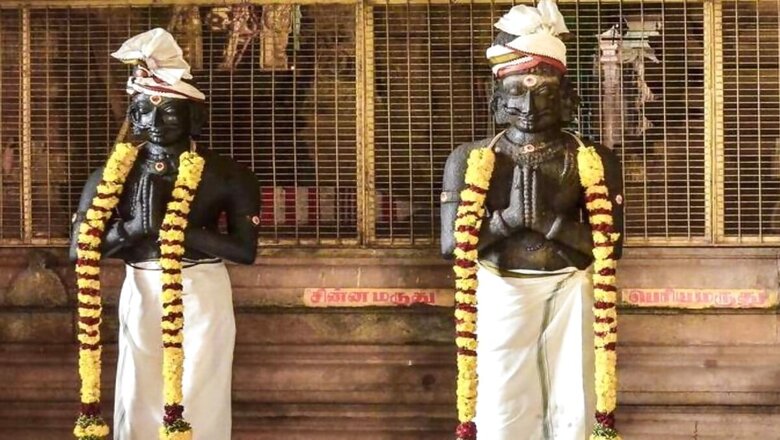
views
“The lack of unity and friendship amongst you has led you to blame each other among yourselves. You are incapable of understanding the intrigues of the Europeans whereby you have handed over the country to the aliens. In all the regions now ruled by these abominable, our people are living in utter poverty…. Even if one lives for one thousand years, his death is certain. Therefore, everyone living in different poligars must come together like a warrior to throw the foreign yoke.”
These are the extracts from a poster, known as Jambu Dweepa Prakadanam (proclamation in English) which shook the East India Company (henceforth called Company), alien rulers who surreptitiously entered as traders hiding the evil intentions of gaining political power in due course. To know the what, when, where, and why, here is a little history of Southern India.
Grim Gloomy Scenario
The Europeans themselves had recorded that there existed a simple but effective three-tier system of polity and administration within built checks and balances. At the apex level, kingdom or princely states, poligars (paalayakaar or zamindaar in native language) at the intermediary level and the village panchayats at the third or base level. Palayams were created during the rule of the Vijayanagar empire. They sub-divided their empire into 72 palayams (probably comparable to modern-day taluks or districts) for better administration. By and large, the institutions of administration remained sound and the rights of the inhabitants were left inviolate. In spite of the internal conflicts, the country seemed prosperous.
This scenario was turned upside down by the Company over the course surreptitiously in the beginning and blatantly, particularly after the decisive victory of French forces at Wandiwash (Vandavasi in Tamizh) and Tiruchirapalli. Aggressiveness and brutality went up further after the three Carnatic wars.
How they tackled the revolting kings and poligars by enticement, deceit, lending at high rates of interest and forcefully their lands when they could not repay the debts (reader is right if he or she recalls the machinations of modern-day China to expand their areas of influence) have been adequately recorded in the history.
At the village level, agriculture, industries, trade and arts were systematically destroyed due to political instability, lack of patronage from the kings and poligars, high taxes, usurious interest rates, restrictions on movement, arson and looting instigated by aliens and their local agents, and above all, the failure of monsoon, particularly in and around Vellore, Madurai, Ramanathapuram etc.
Significance of Sivagangai
Herein, a special mention of the Sivagangai kingdom which occupied a prominent place in the freedom struggle of our country at various stages. Sivagangai town, situated in Madurai, was a prosperous kingdom ruled by Sasivarna Periya Odaya Thevar, who was then succeeded by his brother Muthu Vaduganatha Periya Odaya Thevar. He refused to pay the taxes to the Company. Thus, the infuriated Company along with the troops of Nawab of Arcot, waged a battle led by Lt. Col. Ben Jour in 1772 where Muthu Vaduga Nathar was shot dead. His wife Velu Nachiyar went into exile for eight years. All these years, Maruthu Pandiyar brothers displayed exemplary loyalty to and assisted Velu Nachiyar in rebuilding the army. They successfully reclaimed the Sivagangai fort and Velu Nachiyar ascended the throne once again. Her political acumen, valour and ability to collaborate with like-minded forces in the fight against the Company rule are to be remembered forever. When she also passed away, after several twists and turns, power was entrusted to the Maruthu brothers as they had earned the confidence of the ruling family as well as the common citizens of the kingdom.
Maruthu brothers did not fail to meet the expectations. Several historical records and folklores bear testimony to their good governance based on Dharma. They are aptly called as Rama–Lakshmana to work in unison to uphold the noble values of rendering services in the protection of the territory. They were pious (Shiva bhakts), gentle with the people, firm and stern with the enemies. They continued with the policy of non-obedience to the Company Rule.
Maruthu brothers shrewdly stitched together a pact among poligars of Madurai, Ramanathapuram, Thanjavur, Panchalankurichi (lead role played by legendary Veera Pandia Kattabomman) and Sivagiri. They all caused a series of surprise attacks during 1798-1800 when the Company’s forces were preoccupied with quelling the unrest in the Mysore region. These attacks fetched rebel forces arms and ammunition. They also recovered food grains to distribute to the suffering people. After the hanging of Veera Pandia Kattabomman, the Maruthu brothers gave refuge to Kumaraswamy Naicker (aka Oomaithurai), the younger brother of Kattabomman and kept the flame of struggle alive.
The Proclamation
Maruthu brothers took their struggle to a new height by releasing a proclamation known as Jambu Dweepa Prakadanam. On June 16, 1801, the younger Maruthu (Chinna Maruthu), posted at the Tiruchirapalli Fort and Sri Rangam temple walled a poster which exhorted all sections of the society, including Muslims, to come together to rebel against the oppressive European rulers. The proclamation clearly advised everyone to do away with evil-minded lowly aliens by all means. It also cautioned the men not to cooperate with aliens and if found to be supporting the aliens, they would also meet the fate of the Europeans.
What is so special?
Generally, it was charged against the poligars and native kings that they could not look beyond their noses, meaning their protest was limited to the four corners of their territory and the tax earnings. Jambu Dweepa Proclamation clearly establishes the Maruthu brothers’ understanding of the then-prevailing situation, the causes of such misery and the roadmap for the action ahead to get out of the afflicting malady. What is to be noted is that the Maruthu brothers genuinely expressed their empathy with the common man. It underscores the need for unity. It talks about the liberation of the entire Southern Peninsula. It was indeed a grand vision statement for a long and sustained freedom struggle.
After Effect
Though various poligars had come together under local level alliances such as Tirunelvi/Dindigul/Ramnad leagues or Coimbatore Chief with Kannada rulers, those initiatives gained further fillip with the active support and particularly after Jambu Dweepa Proclamation. The period of 1801-1806 saw frequent and consistent upheavals from the Southern coastal towns of Ramnad to the Western coast of Dharwad and moved closer to Scindia’s territory (present-day Madhya Pradesh). These struggles continued ceaselessly even after the Maruthu brothers surrendered to avoid the blast of Shiva temple towers at Kalayarkoil. They were hanged in public view similar to Kattabomman. The relatives of the Maruthu brothers and all who associated themselves with the rebellions were hunted, butchered, maimed and sent across the oceans up to Malaysia.
That is why many historians quoting eminent Prof. K. Rajayyan regard the rebellions during 1800-1801 as the first war of independence, which occurred half a century before 1857.
Jambunaathan, an ex-banker, is an active participant in movements upholding Dharmic and nationalistic values. Views expressed are personal.

















Comments
0 comment